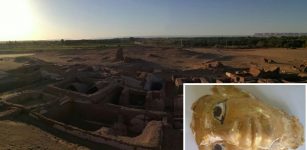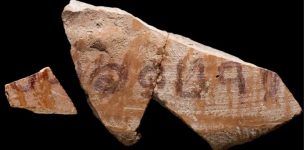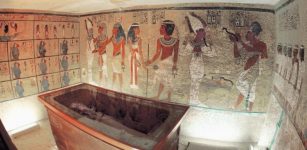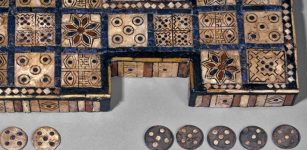Uplistsikhe Devastated By Genghis-Khan Hordes But Once City-Fortress Of Queen Tamar
A. Sutherland - AncientPages.com - Uplistsikhe (today in ruins) is a cave-town fortress, one of the oldest religious, political and cultural centers of present-day Georgia located at the crossroads of Western Asia and Eastern Europe. In ancient times, Uplistsikhe was a pagan holy place.
Caves at Uplistsikhe. Image credit: BBCLCD - CC BY-SA 4.0
The city was also one of the oldest urban settlements in the Caucasus. It arose at the dawn of the Iron Age, at the beginning of the first millennium BC and stood directly on the path of the old Silk Road.
Over three thousand years of its history it has experienced several ups and downs. In 13th century, it was destroyed by the invading Mongols led by Hulagu, Genghis Khan grandson, in the XIII century. Then it was left and abandoned.
The long history of the cave-town fortress, Uplistsikhe, is still recognizable in the remains of unique architectural buildings of different ages, religions and civilizations, all buried in several layers beneath the ground.
Uplistsikhe, of which name means - ‘fortress of the ruler (or ‘fortress of the lord’), is a huge cave city, about 10 kilometers from the town of Gori and carved into volcanic rocks on the shore of the river Mtkvari.
It arose at the dawn of the Iron Age, at the beginning of the first millennium BC.
The city is divided into three parts: south (lower), middle (central), and north (upper) covering an area of approximately 8 hectares. The largest, central part of Uplistsikhe is connected to the southern part via a narrow rock-cut pass and a tunnel. The city had a central “street” connected with a number of narrow alleys and staircases leading to many different structures.
Uplistsikhe Caves. Image credit: Dudva - CC BY-SA 4.0
In the past, the city was surrounded by a protective moat surrounding it from the east and the north. Uplistsikhe had four gates from all parts of the world. Today, this ancient place still has the two-column “reception hall of Queen Tamara” decorated with huge pylons and arch niches attesting to the high skills of the builders. Wine storages, fragments of temples and fortifications, and the secret underground tunnel used for water supply are still intact.
Niches and stairs carved in the cliffs along the river, centuries ago, lead into the fascinating ruins of living quarters, storage, temples, especially the Palace of Queen Tamar, the most extraordinary ruler in the Georgian Golden Age. Tamar was named “King of Kings and Queen of Queens”.
"Queen Tamara (1169-1212), who reigned from 1184 to 1212 ruled over the largest territory ever to come under the control of Georgia; during her reign, the kingdom stretched from Azerbaijan, north of present-day Iran, to the borders of Cherkessia, in the North Caucasus.
Queen Tamar was enthroned as ruler of Georgia at the age of eighteen. She was called “King” because her father had no male heir and so she ruled as a monarch and not as a consort." 1
The majority of the caves are lacking decorations. The central ensemble, a big hall with a coffered tunnel-vaulted ceiling, and the palace complex is the most interesting architecturally. The ribbed ceiling with an aperture, a smoke outlet that also admitted light, was supported by two columns carved from the living rock; the hall had niches-loggias on three sides.
Archaeological excavations revealed numerous antiquities a pharmacy, a wine cellar, and a secret tunnel to the river. There are still many inaccessible and yet unexplored caves in the area of this monumental city.
The ancient city of Uplistsikhe, without exaggeration, was one of the most important monuments of Georgian culture.
Queen Tamar is also associated with the Vardzia monastery which consists of "over six thousand apartments in a thirteen-story complex. The city included a church, a throne room, and a complex irrigation system watering terraced farmlands. A complex irrigation system watering terraced farmlands was also constructed and in some tunnels, the old irrigation pipes still bring drinkable water." 1
Written by – A. Sutherland - AncientPages.com Senior Staff Writer
Copyright © AncientPages.com All rights reserved. This material may not be published, broadcast, rewritten or redistributed in whole or part without the express written permission of AncientPages.com
Expand for referencesReferences:
More From Ancient Pages
-
 Moses’ Secret Knowledge Of Superior And Forbidden Technology – Alien Intervention And Events Erased From Historical Records – Part 2
Ancient Mysteries | Sep 24, 2020
Moses’ Secret Knowledge Of Superior And Forbidden Technology – Alien Intervention And Events Erased From Historical Records – Part 2
Ancient Mysteries | Sep 24, 2020 -
 Laocoon – A Trojan Priest Who Offended The Gods And Was Strangled By Sea Serpents
Featured Stories | Nov 15, 2021
Laocoon – A Trojan Priest Who Offended The Gods And Was Strangled By Sea Serpents
Featured Stories | Nov 15, 2021 -
 Extraordinary 5,000-Year-Old Astronomical Event Depicted On Indian Rock Carving
Archaeoastronomy | Jan 9, 2018
Extraordinary 5,000-Year-Old Astronomical Event Depicted On Indian Rock Carving
Archaeoastronomy | Jan 9, 2018 -
 2,000-Years-Old Warrior Graves With Iron Swords, Mysterious Square Structures, Unearthed In Bejsce, Poland
Archaeology | Nov 21, 2019
2,000-Years-Old Warrior Graves With Iron Swords, Mysterious Square Structures, Unearthed In Bejsce, Poland
Archaeology | Nov 21, 2019 -
 New Evidence Of Human Habitation At Panga ya Saidi Cave, Kenya That Dates Back 78,000 Years
Archaeology | May 11, 2018
New Evidence Of Human Habitation At Panga ya Saidi Cave, Kenya That Dates Back 78,000 Years
Archaeology | May 11, 2018 -
 Stonehenge Served As An Ancient Solar Calendar And We Know How It Worked – Scientists Say
Archaeology | Mar 2, 2022
Stonehenge Served As An Ancient Solar Calendar And We Know How It Worked – Scientists Say
Archaeology | Mar 2, 2022 -
 Five Ancient Roman Tombs With Different Architectural Style Discovered In Egypt
Archaeology | Aug 26, 2017
Five Ancient Roman Tombs With Different Architectural Style Discovered In Egypt
Archaeology | Aug 26, 2017 -
 Enigma Of The Missing Pyramid Bodies – Ancient Egyptian Mystery Remains Unsolved
Ancient Mysteries | Dec 10, 2018
Enigma Of The Missing Pyramid Bodies – Ancient Egyptian Mystery Remains Unsolved
Ancient Mysteries | Dec 10, 2018 -
 Rare 3,000-Year-Old Jerubbaal Inscription Of Biblical Judge Discovered In Israel
Archaeology | Jul 14, 2021
Rare 3,000-Year-Old Jerubbaal Inscription Of Biblical Judge Discovered In Israel
Archaeology | Jul 14, 2021 -
 Voynich Manuscript: Ancient Book Nobody Is Able To Read
Artifacts | Jun 24, 2013
Voynich Manuscript: Ancient Book Nobody Is Able To Read
Artifacts | Jun 24, 2013 -
 New System Will Give Stone Age Skeletons And Mummies Unique Names
Archaeology | Oct 2, 2024
New System Will Give Stone Age Skeletons And Mummies Unique Names
Archaeology | Oct 2, 2024 -
 Australia’s Two-Meter-Long And Oldest Known Rock Painting Of A Kangaroo – Revealed
News | Feb 23, 2021
Australia’s Two-Meter-Long And Oldest Known Rock Painting Of A Kangaroo – Revealed
News | Feb 23, 2021 -
 Lacrosse Was Invented By Native American Indians
Ancient History Facts | May 1, 2016
Lacrosse Was Invented By Native American Indians
Ancient History Facts | May 1, 2016 -
 Ruins Of The Ancient City Of Palmyra Documented – What Remains After The Fall Of The Assad Regime
Archaeology | Feb 14, 2025
Ruins Of The Ancient City Of Palmyra Documented – What Remains After The Fall Of The Assad Regime
Archaeology | Feb 14, 2025 -
 Young Boy Discovers Rare Ancient Roman Treasure In Sussex, UK
Archaeology | Apr 15, 2024
Young Boy Discovers Rare Ancient Roman Treasure In Sussex, UK
Archaeology | Apr 15, 2024 -
 Mysterious Advanced Underground Civilization And A Secret Society – Astonishing Discovery And Connection – Part 1
Ancient Mysteries | Apr 21, 2018
Mysterious Advanced Underground Civilization And A Secret Society – Astonishing Discovery And Connection – Part 1
Ancient Mysteries | Apr 21, 2018 -
 Sinister Mythical Dark Elves And Light Elves And Their Magical Ship ‘Skidbladnir’
Featured Stories | Oct 3, 2016
Sinister Mythical Dark Elves And Light Elves And Their Magical Ship ‘Skidbladnir’
Featured Stories | Oct 3, 2016 -
 Non-Invasive Radar Will Search King Tutankhamun’s Tomb For Nefertiti’s Hidden Crypt
Civilizations | Sep 24, 2015
Non-Invasive Radar Will Search King Tutankhamun’s Tomb For Nefertiti’s Hidden Crypt
Civilizations | Sep 24, 2015 -
 Why Was The Magical Sword Azoth Of Paracelsus So Special?
Featured Stories | Dec 24, 2020
Why Was The Magical Sword Azoth Of Paracelsus So Special?
Featured Stories | Dec 24, 2020 -
 Royal Game Of Ur – One Of The Oldest Game Boards Discovered
Ancient History Facts | Feb 3, 2016
Royal Game Of Ur – One Of The Oldest Game Boards Discovered
Ancient History Facts | Feb 3, 2016



